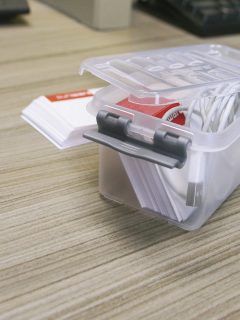Successful and expeditious shipment requires the proper completion of all required documents, labels and tags that will contain information in accordance with shipping, client and government requirements.
Documentation – Domestic Shipment
A domestic shipment does not require as extensive documentation as an international shipment. The necessary shipping document is a filing form and address label that contains the following information:
- the address and contact details of the sender,
- the weight of the shipment,
- the address and contact details of the addressee,
- information on whether it is a cash on delivery (including the amount),
- whether the documents are to be returned from the addressee to the sender.
In addition, the Czech Post filing slip contains:
- Postal code and filing numbers,
- whether the parcel is a hand-delivered parcel or a parcel delivered to the post office,
- disposition of the sender (store for 3 days, do not store, verify details, etc.).
Samples of Czech Post address labels:
Sample address label 1
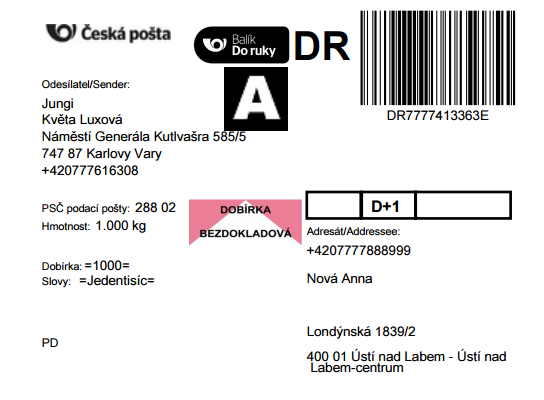
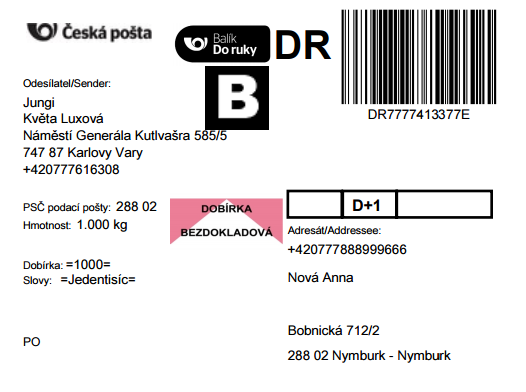
Sample address label 2
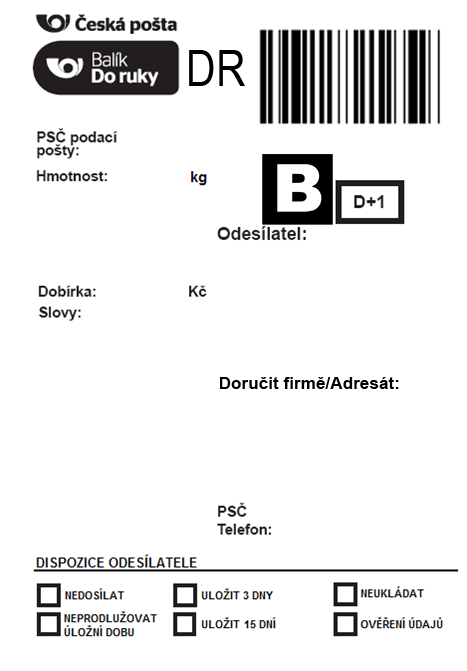
You can download the submission forms for sending a domestic shipment from the Czech Post website – Forms and Forms section.
You can fill in and send the submission form in the form of a postal submission sheet electronically on the Czech Post website. Instructions for the use and submission of the electronic submission sheet (ePA) are available for download on the Czech Post website. In addition to the address label, the domestic parcel should also contain labels that specify the type of service or COD, if applicable to the parcel. You can also download the labels from the Czech Post website.
Global shipping companies such as FedEx, DHL or UPS allow you to send your parcel easily online. You can fill out the submission slip directly on the carrier’s website. The physical package must include a label or address label on its packaging with the address, name and contact details of both the sender and the recipient. FedEx, DHL and UPS all have their own address labels that need to be placed on the package. All address labels contain the same information and differ only in the carrier’s logo and appearance.
When shipping domestically, don’t forget the handling marks on the package such as, do not tip, fragile, protect from moisture, etc. However, handling marks do not serve as a substitute for quality packaging. Some companies, such as UPS, state in their terms and conditions that they do not provide special handling for packages. Remember that a shipment may contain only one address label. UPS recommends placing the shipping label with address and contact information on the top of the package, not over the joint or adhesive tape. Any previous labels or outdated address labels must be removed from the shipment packaging or significantly crossed out. UPS also provides a smart label shipping label. Smart Labels can be generated using the UPSWorldShip app, printed and applied to the package. They not only serve for convenient and accurate delivery of the shipment, but also for tracking the shipment during transport.
Documentation – International Shipment
International shipment requires extensive documentation, especially when shipping to countries subject to customs duties. The specific documents vary depending on the type of goods, the country to which they are being shipped, and the country from which the international shipment is being sent. The most commonly required documents for an international shipment include:
- Shipment Label (Sea Waybill/Air Waybill) – A bill of lading, or Shipment Label, must be included with every single international shipment. The Sea Waybill (SWB) is required for shipments by ship and the Air Waybill (AWB) for shipments by air. It serves as a transport document issued by the carrier. It lists all the detailed information needed for the shipment, such as:
- delivery address,
- the name and contact details of the addressee,
- information and contact details of the sender,
- type of transport (by plane, ship, truck, train, mail, or a combination),
- the reference number of the consignment,
- tracking and tracing code,
- country of origin,
- the weight and dimensions of the consignment (in the Anglo-American system of measurement and also in the metric system),
- special instructions (Fragile, This Side Up, Use No Hooks, Keep Dry, Keep Away From Heat, etc.) in English and in the local language of the place of delivery,
- the number of parcels/pallets in the shipment, and
- a label of internationally recognised symbols identifying the hazardous material.
- Bill of Lading (B/L) – This is an important transportation document that serves as a contract between the carrier (e.g. UPS) and the shipper (e.g. a specific airline). It contains all the information for delivery with instructions for shipment. Anyone who holds a B/L is entitled to the cargo, or the right to receive the cargo. Each shipping company has its own B/L form, for each mode of transportation.
Example, sample B/L document from UPS.
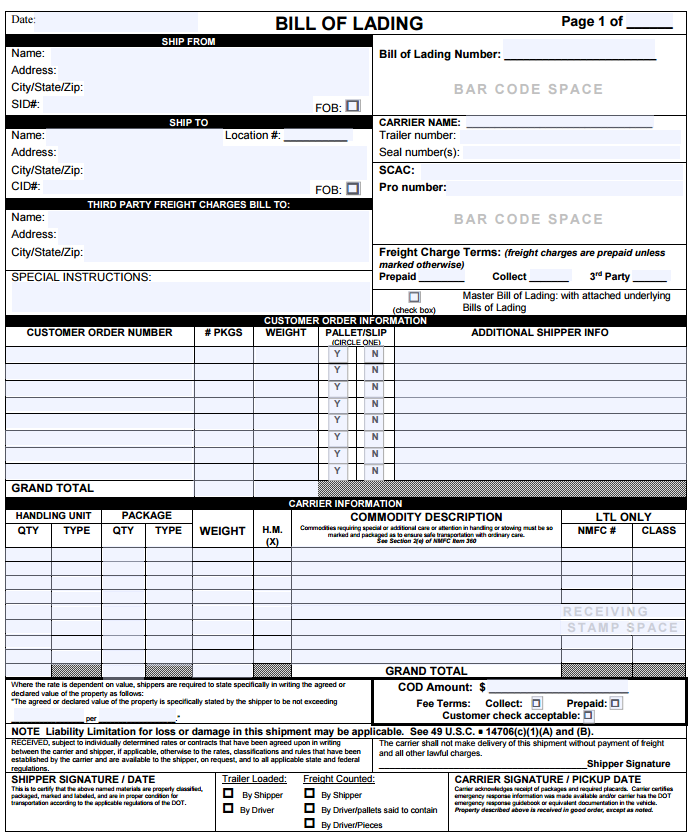
- Standard Shipping Note (SSN) – is a shipping document that provides detailed information about the contents of the shipment to carriers and receiving authorities. The SSN can be used for all shipments except dangerous goods. It is required for shipments to and from the UK. A template SSN can be downloaded from the International Trade Files section of the BusinessInfo.co.uk website.
- Commercial Invoice – An invoice or accounting document for a shipment sent by a seller to a buyer. This document is used by governments to calculate the amount of duty and other export charges. It is the primary document for authorities to control exports and imports. It contains seller and buyer information including telephone contact, terms of sale, reason for export, complete list and description of goods, country of origin, number or volume and weight of shipment, delivery information, and hand or electronic signature of the shipper. You can download a document to complete at ShipNorthAmerica.com.
- Certificate of Origin – A document or declaration of the country of origin of the exported goods.
- (Export) Packing List – A detailed list of materials in each package, box, pallet or container. The Packing List includes the unit weight of the shipment, the gross weight of the shipment, and the dimensions of the package or pallet.
- Shippers Export Declaration (SED) – This document is used by the U.S. government for export control and official statistics.
- Export License – some types of goods require an export license. A license is government permission to export specific goods in authorized quantities to a pre-approved country. An export license may be required to export any type of goods to selected countries, or a specific type of goods to specific countries. It can be a series of documents:
- Insurance Certificate,
- Shipper’s Letter of Instruction,
- Inspection Certificate,
- Consular Invoice.
- Dock Receipt and Warehouse Receipt -a document used to transfer responsibility when an export shipment is moved by a domestic domestic carrier to a port of embarkation where it is left for export in the hands of an international carrier.
- Destination Control Statement – A statement included on the commercial invoice, bill of lading (Sea Waybill or Air Waybill) and SED to notify the carrier and all parties involved that the goods in question can only be exported to certain destinations.
- NAFTA Certificate – This certificate is required when trading goods between NAFTA member countries.
Global shipping companies such as DHL, FedEx and UPS provide electronic shipping label software for their clients. So-called smart labels, such as RFID labels, are a type of electronic label (AutoID) that is automatically generated by the shipping company’s software after the required data is entered. The unique code of the electronic shipping label thus provides all the necessary information about the shipment and delivery after a simple scan.
Not all of the above documentation for an international shipment is mandatory. The number of documents required varies depending on the country into which the shipment is imported. You have several options to determine which ones you will need to submit to the appropriate authorities before sending and receiving an international shipment.
-
- Instructions for importing and successfully delivering your shipment will often be provided by the embassy or consulate of the country to which you are shipping.
- A detailed list with instructions for air freight to selected countries is continuously updated on the Air Cargo Tariff Guidebook.
- On the websites of shippers, authorities, organizations and associations involved in international trade and shipping, you can find information on specific international shipment documentation that is commonly required for international trade and shipping. For example:
Adhere the shipping documents to the package in a waterproof envelope and print the text in waterproof ink. Place markings and warning labels on three sides of the container or package, preferably on the top and on the front and back. Include handling and warning instructions on the package in the language of the place of delivery (especially the airport or port), not just in English. Clearly and legibly state your name, address and contact details on the packaging. The package must not be missing the name and delivery address, country of origin, package identification number, weight and dimensions. If the shipment consists of multiple packages, the bill of lading must indicate the number of packages in the shipment. Each carrier has its own identification marking, in the form of a sticker or self-adhesive tape with a logo, which you can use for easy identification on the package.
DHL documentation for international shipments
-
-
- DHL Waybill (Shipment Label – Sea Waybill/Air Waybill) – to be completed electronically when ordering a shipment online at MyDHL.DHL.com (for instructions on how to complete the DHL Waybill correctly, please visit DHL.com).
- Export Cargo Shipping Instruction (ECSI).
- Standard Shipping Note (SSN).
- Export Declaration.
- Commercial Invoice (you can fill out a template in the Customs Documentation section of DHL.cz).
- Shipment Receipt.
-
You can download the DHL documentation for an international shipment in English for completion at WebShipping.DHL.com:
https://webshipping.dhl.com/wsi/help/EA/en/print_shipment_paperwork.htm
UPS documentation for international shipment
-
-
- UPS shipping label or smart label.
- UPS Worldwide tracking label.
- Commercial Invoice (prepare three copies when sending a parcel shipment).
- Certificate of Origin.
-
UPS provides six different types of shipping labels that contain a combination of information from the address label, tracking label, and the shipment record all in one. You can view the available labels in detail on the UPSwebsite
FedEx documentation for international shipments
-
-
- Air Waybill.
- An extended air waybill that can be used for all FedEx services.
- Commercial Invoice.
- Country-specific customs documentation.
- For more detailed information on Bill of Lading, International Barcode Label, NAFTA Certificate of Origin, Certificate of Origin, Electronic Export Information and Declared Value Shipment Form, visit the Labels Documentation Locations section of FedEx.com.
-
You can find the FedEx documentation with complete instructions for completion in English, along with samples, at FedEx.com/en.











